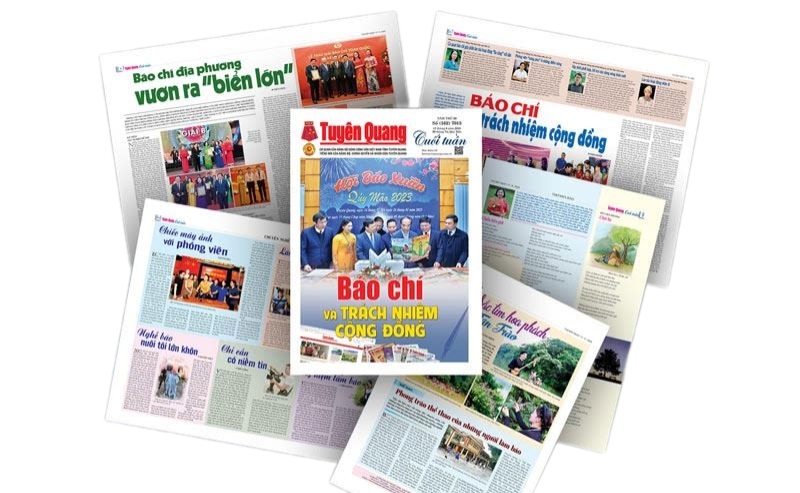Vietnamese media adapting to digital transformation and tech trends
VOV.VN - As the country marks 100 years of revolutionary journalism, Vietnam’s media, led by agencies like the Voice of Vietnam (VOV), is under growing pressure to modernize, adapt to policy reforms, and meet the demands of digital transformation.
The centennial anniversary of the Vietnam Revolutionary Press Day (June 21, 1925 – June 21, 2025) marks a proud historical milestone for revolutionary journalists.
Over the past century, through the struggle for national independence and freedom, and later the cause of building and defending a socialist homeland while pursuing international integration under the leadership of the Communist Party of Vietnam (CPV), the revolutionary press has consistently served the country. It has upheld the national interest and the people’s well-being, grown steadily in all aspects, and become a core, pioneering force on the ideological and cultural front; it has firmly defended the Party’s ideological foundation.
Today, the Vietnamese press, including VOV faces major opportunities and challenges in fulfilling its mission and the tasks entrusted by the Party and the State. It must maintain its role in shaping public opinion and pursue modernization and professionalism. In particular, in this historic phase, Vietnam’s press and media must undergo changes to meet the demands of policy reform, digital transformation, and multimedia platform development.
When founding Thanh Nien (Youth) newspaper, the origin of Vietnam’s revolutionary press, President Ho Chi Minh, a beloved leader and a great journalist, understood clearly that journalism was a powerful and sharp tool for promoting the revolution and mobilizing the masses. Indeed, over the past hundred years, the revolutionary press has proudly fulfilled this vital role.
As the country advances into a new era of prosperity and development, the press must continue to fulfill its mission, first and foremost by propagating policies. Media agencies, including VOV, serve as essential channels for disseminating Vietnam’s development aspirations, the goals set for the country’s centennial milestones, the Party’s resolutions, National Assembly decisions, Government directives, and society-wide engagement for a shared future.
At this moment and in the coming period, policy communication is a heavy task with extremely high demands, given that public policy remains a top priority in national development and in safeguarding security and defense. Communicating policy must be a two-way process.
The press must truly act as a bridge between the Party, the State, the National Assembly, the Government, local administrations, and the people. It must explain Party guidelines, policies, and laws while also serving as a democratic forum that reflects public sentiment and legitimate aspirations back to the Party and State. More importantly, it must highlight the outcomes and impact of those policies.
Rapid changes are placing unprecedented demands on the press in policy communication. Any failure to keep up could result in diminished relevance and loss of public trust. For this reason, the press in general, and VOV in particular, has been working to innovate, improve, and respond creatively and promptly to issues of broad public concern.
Recent reporting has covered matters such as public input on the draft resolution amending several provisions of the 2013 Constitution; the implementation of Resolutions 57, 59, 66, and 68 of the Politburo, known as the "Four Pillars" which focus on science and technology, innovation, digital transformation, foreign affairs and international integration, and turning the private sector into a primary growth driver; and the restructuring of the two-tier local government model.
In just four recent sessions, the National Assembly has debated and adopted 67 laws, accounting for 31.4% of the 213 laws currently in effect. This is a large number. The press and media must actively keep pace to inform the public about the country’s legislative reforms and the National Assembly’s determination to remove institutional bottlenecks, implement the Party’s resolutions, and realize the strategic vision of national leaders. The entire system is undergoing rapid, comprehensive change, and journalists must stay alert, responsible, and adaptive to capture “the pulse of life and the country’s transformation.”
The press must constantly adjust its methods to meet new requirements in information and communication, particularly concerning new policy directions. At the same time, media organizations must also carry out these new policies, including those specifically targeting the press itself.
The Government and National Assembly are now focusing on revising the 2016 Press Law, an issue of strong interest within the media sector. Expectations are high for new provisions that will institutionalize the Party’s policy directions, provide a legal basis for media agencies to develop in the context of rapid technological change, reorganize media structures, tackle fierce competition in news dissemination, and ensure adequate investment in equipment and capacity. These changes are opening a new chapter for Vietnam’s revolutionary press as it continues to accompany the nation in building a prosperous, civilized society and a modern, professional, and humane journalism sector.
Today, press agencies are facing both major opportunities and challenges in the digital transformation process. On one hand, technological platforms are seeing rapid development, including artificial intelligence (AI), big data, and digital content distribution systems. On the other, public demand for information, especially among younger audiences, is increasingly diverse and personalized. Vietnam also faces the risk of losing sovereignty over digital content and information due to foreign-owned platforms.
At VOV, to fulfill our information and communication duties, the national broadcaster has in recent years adopted a multimedia model and actively implemented digital transformation despite limited resources in equipment, technology, and experience. Initial results have been encouraging, but VOV recognize that continued progress requires us to embrace the principle of “transform to adapt.”





